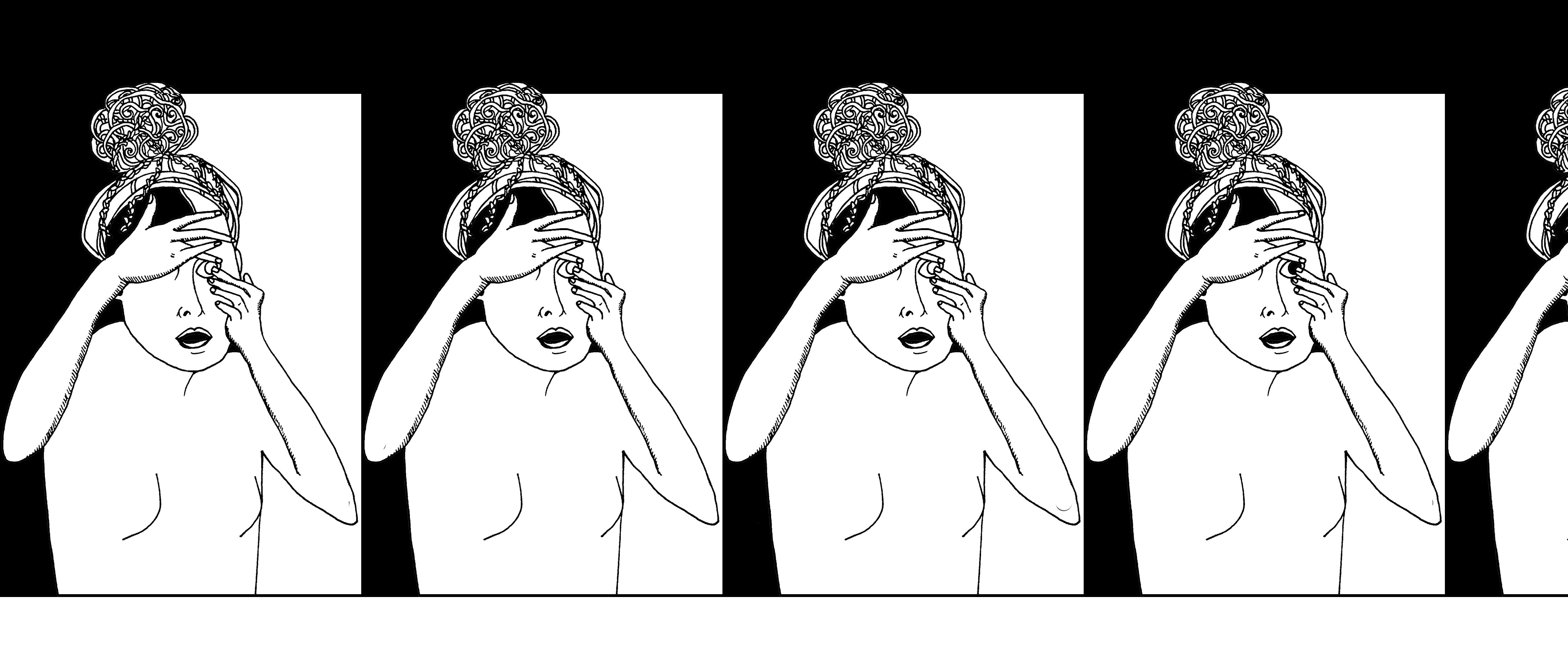Poetry Comics: You Must Look Her in Both Her Eyes

Each month we feature a guest post from a contributor to Poetry’s current issue. Gabrielle Bates’s visual poem “Imogen and the Beginning of Color (an Excerpt),” created with Adrienne Raphel, appears in the February 2019 issue. Previous posts in this series can be found on the Editors’ Blog.
I am seven years old, sitting at the old diner booth we use as a kitchen table when my stepmother confronts me about a face that keeps recurring in my sketchbook. She opens it up to show me: a black ink drawing of a woman’s face split sharply down the middle, a different type of hair, skin, and eye on either side. These drawings, my stepmother says, are not innocent. With these split figures, I have exposed myself as harboring a “two-facedness,” an evil that must be stamped out. In the drawings, she sees my birth mother’s influence, which must be eradicated.
Over the following years, I draw less, fearful of what new sinful inclination my art might expose. I pray at night for light to flood my brain and wither the disturbing plants that grow there. But despite these earnest efforts, my imagination continues to harbor split girls, strange girls.
By the time I go to college, my creative efforts have shifted entirely to writing, and when I stumble upon the world of poetry comics (thanks to the poet Catherine Bresner), I haven’t drawn in years.
The first time I sit down with my pen to create a poetry comic, I feel like I’m staging a private reunion. No longer a child, I am free, finally, to be childish, which is to say imaginative, playful, wild. As my hand toggles from words to images, images to words, I feel as if I’m reintroducing my two halves. It’s nice to meet you, I say to myself, and she says, It’s nice to meet you too.
Poetry comics depend on what I think of as a dynamic mutuality. It is a form (genre? subgenre? happening? mode?) where meaning is found in integration by dwelling in the between. Juxtapositions form the whole, and to be read truthfully, these contrasts must be considered in relation. In other words, the face is split: to see it, you cannot look only at the left side or the right. You must look her in both her eyes.
Recently, I was supposed to take part in an art exhibition in Cuba. Due to a complicated array of factors (including Decree 349, which took effect in December, criminalizing all art in Cuba that hasn’t received governmental approval), the show did not occur. The piece I’d created and sent to Havana (a piece whose physical whereabouts are now unknown to me) was an attempt at a poetry comic ars poetica. It stars a woman, reproduced several times, reaching as if to remove from her own eye (or apply to her own eye) her pupil, much as one would remove or apply a contact lens. Beneath her is the command “think, eye” four times, alternating lower case and upper case letters (“think, eye” “think, eye” “think, eye” “think, eye”).
In unpacking the philosophies behind his own hybrid, visual-and-textual work, Teju Cole writes that in the absence of absolute faith (religious, in his case), “[t]he very contingency and brevity of vision become the long-sought miracle.” His visual arena is the world outside of the skull, as mediated by photography, and mine is the one within, as mediated by pen and ink, and yet I think there is a kinship in our compulsions. In my poetry comic ars poetica, I was trying to lean into this contingency but resist the brevity. I wanted to enact the back-and-forth, ebb-and-flow persistence that, for me, lies at the heart of both a poetry comic’s creation and reception. I was trying (and failing, no doubt) to linger in the joint mechanisms of “the long-sought miracle.”
I maintain that poetry comics are a collaborative art, whether there is another person involved or not. In the case of “Imogen and the Beginning of Color,” I am collaborating in a literal, traditional sense, responding to and visually reinterpreting Adrienne Raphel’s (incandescent!) words, but in other poetry comics (such as “In the Circus”), I’m collaborating with myself. There is my child self who thinks in visual images and my adult self who thinks in language, and when they create pieces together, they are able to plumb the darknesses, acknowledge complexities, and evoke experiences they find too difficult to confront on their own.
I find myself wondering, at this point, about you, reader. I wonder if there is a poetry that would allow more of your self/selves to come to the table. I wonder if you are soloing material that requires a chorus. I wonder if there’s a form on the page (or off the page entirely) that echoes more truthfully the ways in which you process your thoughts, your memories, your life. Maybe you are sitting there with your pen, waiting for permission, taking from poetry only what is offered. Maybe you are operating as if you are not worthy of redefining what poetry can be.
Earlier this week, I had the great pleasure of rereading Rick Barot’s Chord in preparation for an episode of the Poet Salon podcast. In that book he writes, “somewhere between / what the eye sees and what the mind thinks / is the world.” As I write this piece, I can’t stop thinking about that “somewhere between.”
I can’t stop wondering how I might meet you there.
Gabrielle Bates is a writer and visual artist from Birmingham, Alabama. She is the author of Judas Goat...
Read Full Biography


